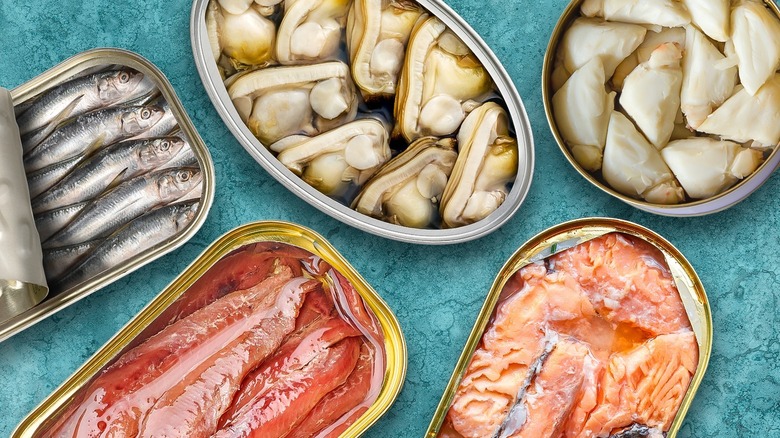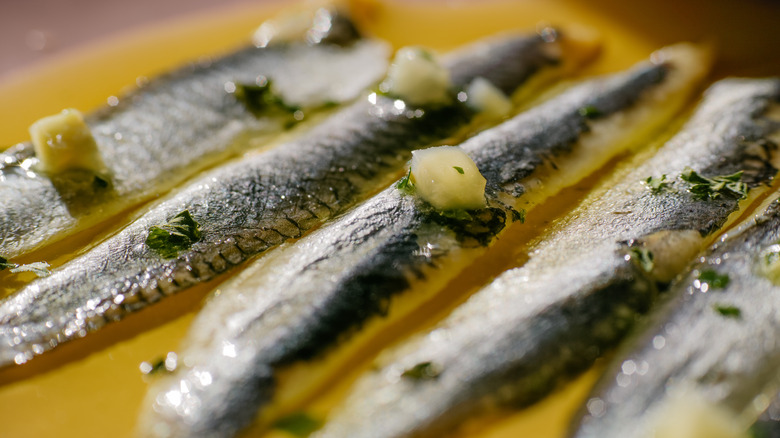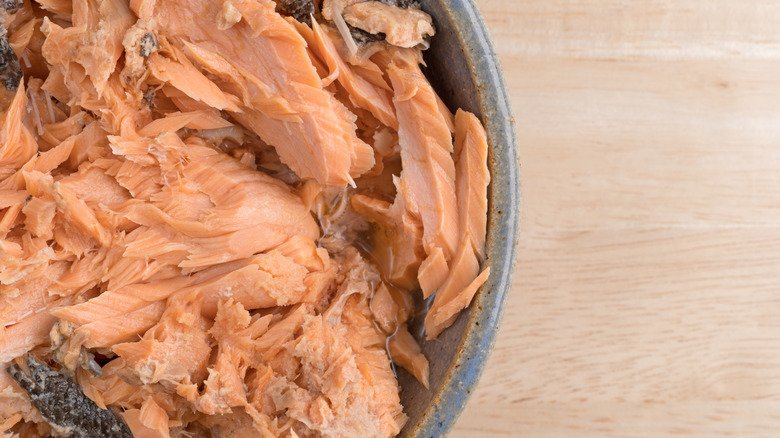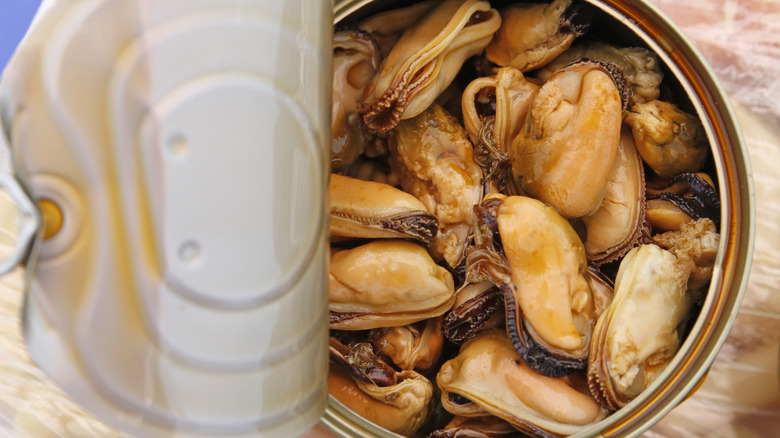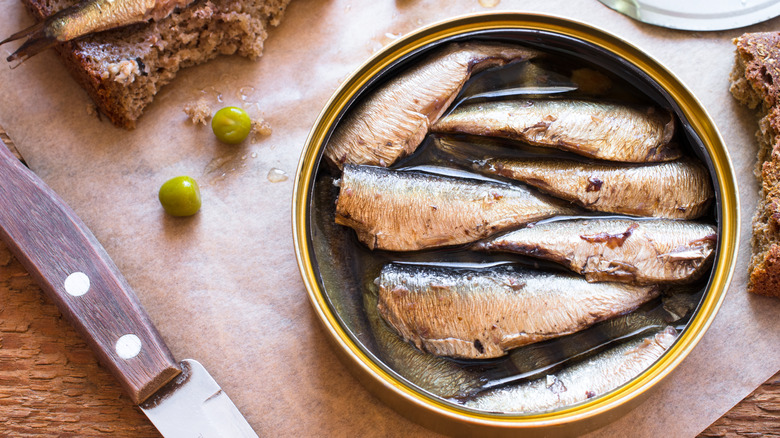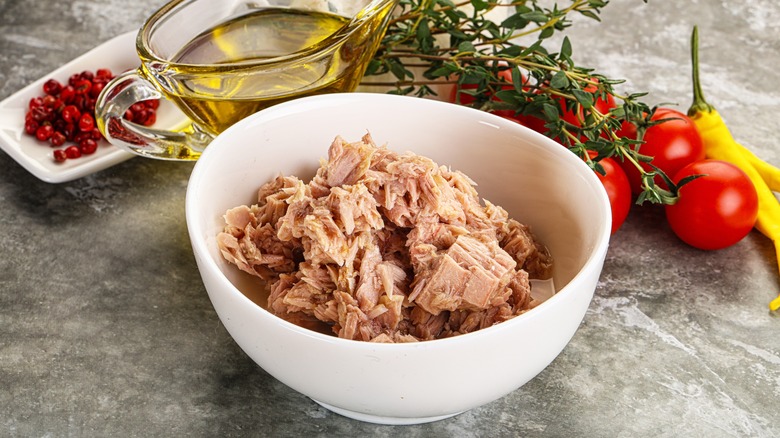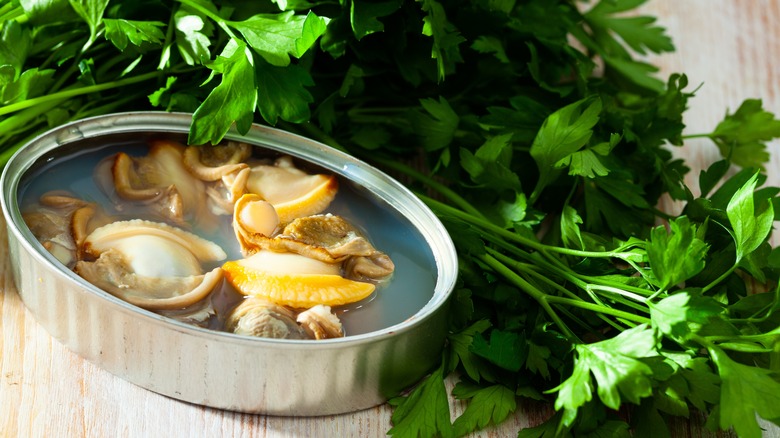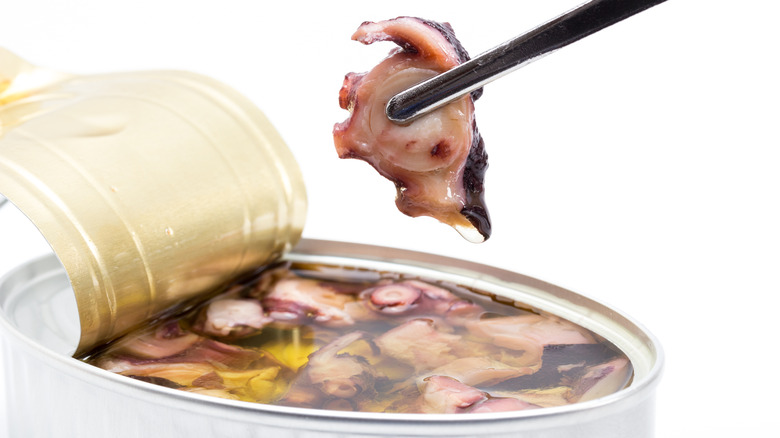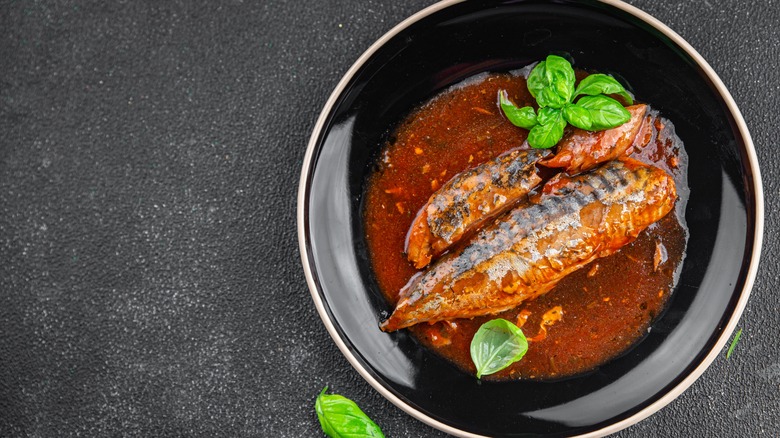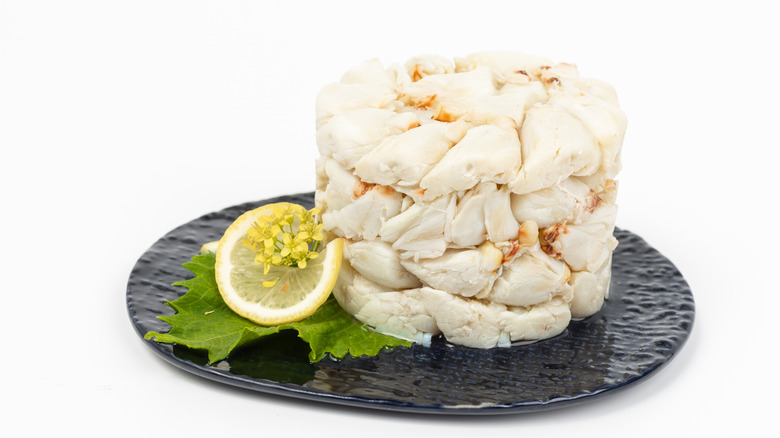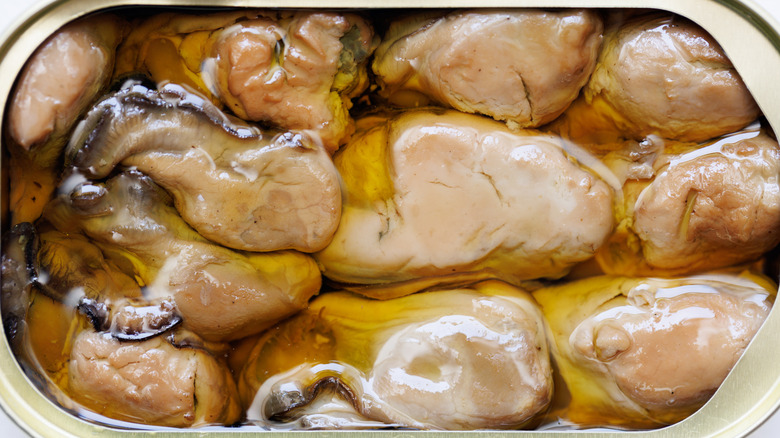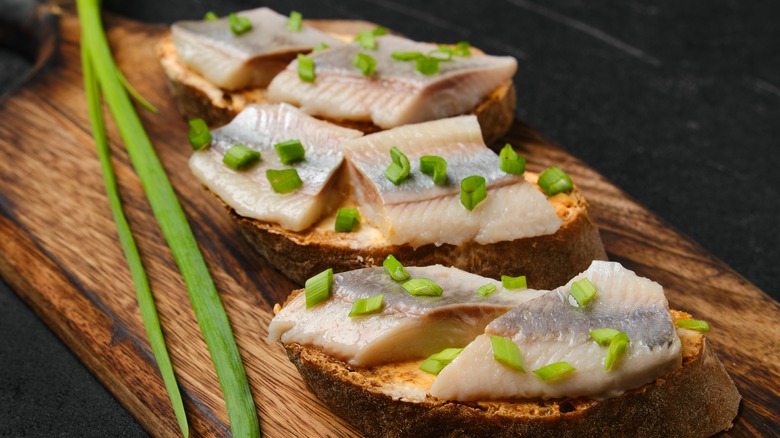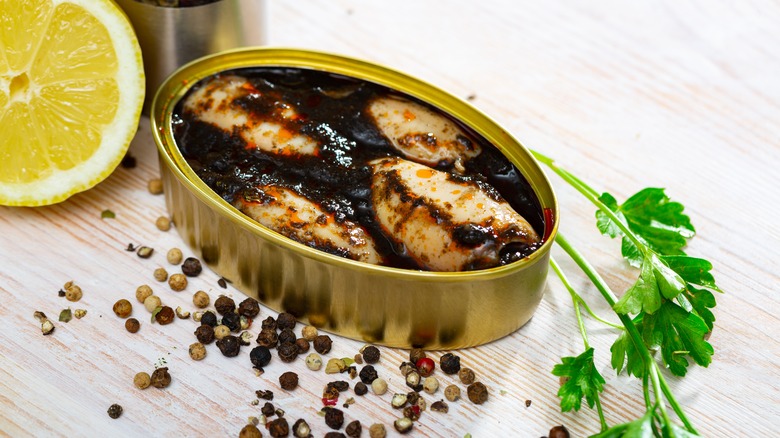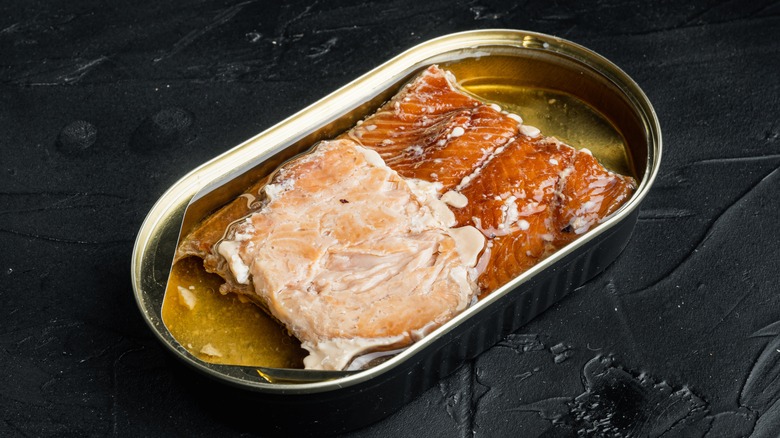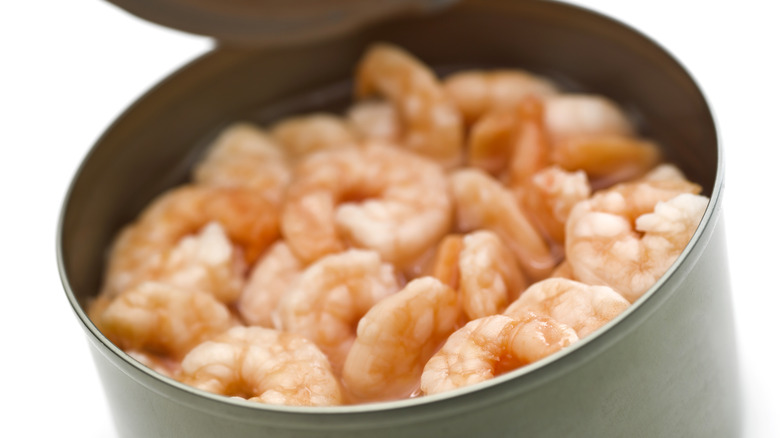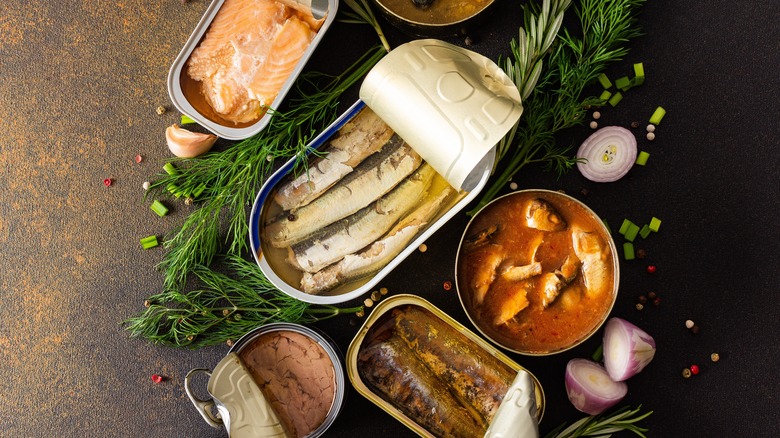14 Canned Fish You Should Have In Your Pantry
Tinned fish is trending right now and for good reason. While fresh fish may be hard to find in some places, nearly every grocery store stocks some form of canned fish. Generally speaking, canned fish can be relatively cheap and contain a hefty amount of protein and heart-healthy omega-3 fatty acids. Plus, those tins will last for ages in your cupboard, making them great staples to have on hand when you want a quick and easy meal.
When you think of canned fish, tuna is probably the first thing that comes to mind. However, there are numerous types of tinned seafood you can try. Think briny oysters, meaty salmon, and delicate crab meat to name just a few. And while tuna may be great in sandwiches, salads, and pasta dishes, other types of canned seafood can be used to make everything from upgraded tacos to protein-packed avocado toast and elegant canapes.
Looking to broaden your canned fish horizons? We spoke to numerous chefs and seafood experts to see which types of tinned fish they recommend for taste, nutrition, and versatility. According to the experts, these are the types of canned fish everyone should have in their pantries.
Anchovies
Nearly every expert we spoke to said anchovies are a must-have in any kitchen. These tiny fish can be found in oceans around the world and they're packed with nutrients like omega-3 fatty acids, vitamin B12, and calcium. Canned anchovies are typically cured with salt, then packed in oil. This gives them a rich, umami flavor. You can eat them whole, bones and all, or incorporate them into salad dressings and sauces. You can also throw a few anchovy fillets on your pizza or in a sandwich for an instant flavor boost.
Some people may turn up their noses at the idea of using oily fish in dishes like salads or pizza. However, anchovies don't have a full-on fish flavor. If you've ever eaten a Caesar salad, there's a good chance you've eaten anchovies without even realizing it. Maggie Turansky, founder of No Frills Kitchen, told Chowhound, "Contrary to what many may think, adding a couple of anchovy fillets to a sauce or salad dressing won't make the dish taste fishy. They simply add a robust umami flavor and distinct saltiness that can add another dimension to whatever it is you're cooking."
Salmon
If canned tuna isn't cutting it for you anymore, you may want to consider upgrading to canned salmon. "Packed with heart-healthy omega-3 fatty acids and with a rich, juicy texture, canned salmon is more luxurious," said Ken Tobby, CEO of Organic Solace. In the showdown between canned tuna vs. canned salmon, the salmon wins points for having a more robust flavor and more omega-3 fatty acids and vitamin D. However, canned salmon is higher in calories than tuna.
Canned salmon is typically packed in water and can come with or without skin and bones. You can also choose from wild or farmed salmon. The canning process includes cooking the meat so that it's ready to eat right out of the can. The flaky, pink or red meat can be eaten on its own or used in a wide variety of dishes. Jessica Randhawa of The Forked Spoon told Chowhound, "It's perfect for making salmon patties, adding to salads, or tossing into pasta dishes. Salmon can be used in everything from casseroles to spreads, making it easy to incorporate into both everyday meals and special dishes."
Mussels
When it comes to canned seafood, shellfish like mussels, oysters, and clams are often overlooked. However, many chefs say that these products can be hidden gems. "I love canned shellfish," Bart van Olphen, co-founder of Sea Tales, said. "The salty flavor in combination with the cooked shellfish does very well. Not only is the shellfish itself delicious, but also the juice coming out of these cans are super for sauces." If you're looking for a delicious and versatile shellfish to add to your canned fish repertoire, mussels are a good bet.
There are several reasons why canned mussels deserve a place in your pantry. First, mussels are high in protein, iron, vitamin C, and calcium. The meat is slightly firm, but also tender with a mild briny flavor. You can get canned mussels packed in oil that are smoked, pickled, lightly seasoned, or amped up with bold, spicy flavors. Crack open a can and you can eat the mussels as-is or on crackers. You can also incorporate canned mussels and the olive oil they come in into a wide variety of dishes like soups, chowders, omelets, pasta, or rice dishes like paella.
Sardines
Sardines look a lot like anchovies in that they're small, silver fish that are typically canned. In fact, sardines are part of the same family as anchovies and other oily fish like herring. However, while anchovies are often used mainly for flavoring, sardines can stand on their own as a delicious snack. "Sardines are a must-have in any pantry," Chef Lawrence Patterson of Decoys Seafood said. "They're packed with omega-3s, and the flavor is rich without being overwhelming. They're versatile and way underrated."
Most canned sardines are steamed or boiled first, then either filleted or packed whole with olive oil. Some cans may have herbs and spices added to enhance the flavor. You can also find sardines packed in brine or tomato sauce. If you want to savor the full flavor of the sardines, you can eat them straight out of the can. There are also multiple other ways you can snack on canned sardines, including adding them to pizza, tossing them in pasta, or air-frying your sardines to make them crispy.
Tuna
It's easy to see why tuna is one of the most popular canned fish options. For one, it's relatively inexpensive and easy to find with multiple canned tuna brands on the market. Tuna is also packed with protein, vitamin B12, and omega-3 fatty acids. Plus, the flavor is relatively mild, which is great for people who don't like seafood that tastes too fishy. Moreover, canned tuna works well in a wide variety of recipes, from refreshing salads to heavy casseroles. And of course, who could forget those classic and comforting tuna sandwiches?
The meaty texture and mild flavor of tuna are what make it so appealing to so many people. However, it can be a bit bland without the right seasonings. "Tuna goes well with bright, fresh foods like basil or parsley, lemon, capers, olives, and tomatoes," Ken Tobby said. Herbaceous and acidic ingredients can enhance the flavor of the tuna well without overpowering it. Tobby also recommended adding creamy elements to complement the flakiness of the fish like Greek yogurt, avocado, or mayonnaise.
Clams
Unless you live close to the ocean, fresh clams may be out of your reach. And while nothing beats fresh, canned clams are a perfectly acceptable substitute. A can of clams will provide you with a decent amount of protein, as well as magnesium, potassium, and vitamin C. You can find canned clams that have been cooked, then chopped, minced, or packed whole in their own briny juices. Smoked clams are another tasty option.
"Clams are my personal favorite and a must in a pantry," Paul DiBari, who is a chef-instructor of Culinary Arts at the Institute of Culinary Education in New York City, said. "Heat them quickly in the broiler with a little breadcrumb and lemon, and you have a delicious snack on a slice of bread." If you're looking for a more elaborate meal, you can also use canned clams to make a creamy clam chowder, a classic linguine vongole, or a fresh seafood salad.
Octopus
Canned octopus may not be as popular as tried-and-true canned fish favorites like tuna and salmon, but many chefs agree that it's a pretty special pantry staple. It's the kind of ingredient you can pull out when you're craving something a bit more elevated than ho-hum tuna salad or want something unique to impress guests. Like many canned seafoods, tinned octopus is cooked first and typically packed in oil. That means you can plate it right away or grab a fork and eat it right out of the can.
Of course, if you want to jazz up this treat, there are plenty of creative uses for canned octopus. The tender, flavorful meat can benefit from a bright hit of lemon juice or a dusting of cayenne powder. Ranveer Brar of Kashkan Restaurants said, "It's great served in Mediterranean dishes as tapas or with flatbreads." You can also sear the octopus and serve it in tacos, combine it with fresh greens for a summery salad, or toss it in pasta with a vibrant tomato sauce. Canned octopus also works well in dishes where seafood is the star like ceviche and aquachile.
Mackerel
Mackerel is another canned fish that many people pass over in the grocery store, which is a shame because it has tons of things going for it. Paul DiBari said, "I think mackerel deserves more recognition in the canned fish world. The health benefits alone are worth it — it's packed with omega-three acids and protein." Mackerel is also high in vitamin D, vitamin B12, iron, magnesium, and potassium.
Beyond the health benefits, mackerel is also ultra flavorful and has an appealing flaky, meaty texture. "Mackerel has a similar flavor to sardines but is slightly less fishy," Ranveer Brar said. "It's a little more oily and softer, a calmer dish that can be eaten on its own or with some lemon and greens." If you want to see for yourself why many believe mackerel is the most underrated tinned fish, you can find cans of it packed in oil, brine, or tasty sauces like tomato, curry, and piri-piri sauce. It also comes smoked, grilled, boneless, and with or without skin.
Crab
For many people, crab is a delicacy that is often only eaten in a seafood restaurant or perhaps at home for a special occasion. But let's face it — it's not the easiest dish to eat. It can be a lot of work to extract the meat from the shells, and sometimes it seems like the payoff is not worth the effort and mess. If you want to enjoy that sweet, delicate meat without the hassle of removing the shells, canned crab is a great option.
There are several varieties of canned crab you can choose from, all of which are cooked and pasteurized before being canned. You could opt for meaty lump crab that comes from the body of the crab. Lump meat is great for dishes where you want the meat to shine like crab cakes and crab salads. Claw meat is darker and full of flavor. It works well in soups and dips. Special crab meat is a mix of lump and flake meat from the body of the crab. It tends to be less expensive than lump meat, but is still flavorful and has a nice texture that works well in dishes like crab cakes, pastas, salads, and omelets.
Oysters
Archaeological evidence shows that humans have been eating oysters for roughly 164,000 years. That's not surprising considering these briny bivalves are nutrient bombs. Oysters contain high levels of vitamin B12, zinc, copper, and iron. Fresh oysters are a real treat, but if you can't get them fresh, canned oysters are the next best thing. You have two choices when it comes to canned oysters: natural or smoked. Natural oysters are usually packed in water, while smoked oysters can be packed in water or oil. Smoked oysters may also contain seasoning like red chili pepper or sriracha chili sauce.
While canned natural oysters offer a blank canvas to work with, many chefs prefer the smoked variety. Ken Tobby told Chowhound, "These tiny, briny oysters have a deep, smoky flavor that goes well with salads, pasta, or appetizers. They also make a simple yet sophisticated snack when served on crackers with a splash of lemon." Some other ways you can use canned oysters include cooking them in a hearty stew, chopping them and mixing them with cream cheese for a luscious dip, or deep-frying them for a crispy snack.
Herring
If you're a fan of small, oily fish, canned herring will be right up your alley. You may also see the fish labeled as kippers, which refers to herring that has been butterflied, salted or pickled, and smoked. Herring and kippers used to be popular breakfast dishes in the U.K., although they're less common as a breakfast dish today. However, many chefs believe they're due for a comeback. "Herring, particularly in mustard or tomato sauce, is another underappreciated option that can add a delicious punch to salads, sandwiches, or even served over grains," Jessica Randhawa said.
Canned herring contains plenty of protein, iron, and omega-3 fatty acids. You can get it smoked, pickled, or natural and packed in oil or water. The bold, rich flavor of the fish pairs well with a wide range of spices and sauces, which is why you can find canned herring flavored with everything from Louisiana Hot Sauce to paprika and horseradish sauce. Many people eat herring straight out of the can or on top of bread. You can also get creative and use it in dishes like potato salad, stew, and pasta.
Squid
Looking for something a bit different than your run-of-the-mill canned fish? Consider canned squid, aka canned calamari. Like canned octopus, squid is fully cleaned and cooked before being canned. It's often packed in oil, although you can also find it in brine or its own ink. Some canned squid also contains sauces like marinara or garlic sauce. Much of the canned squid on the market is chopped, save for a few artisan brands that offer whole baby squid that may be stuffed with ingredients like onions and peppers.
Canned squid can be tender and slightly chewy with a mild seafood taste. Of course, the oil and sauce that it's packed in will also contribute to the taste of the squid. For example, olive oil will give it a rich, slightly herbaceous flavor, while squid ink can provide a briny, umami profile. You can eat the squid right out of the can, although many people prefer to add it to pasta or heat it up and serve it with crusty bread. You can also use canned squid in tacos, on top of rice, or add it to a seafood soup or salad.
Trout
Trout can be found in waters all over the world, so it should come as no surprise that it's also a popular fish for canning. This freshwater fish belongs to the same family as salmon, so there are some similarities between the two. Both offer plenty of protein, as well as omega-3 fatty acids. However, trout is slightly less fatty than salmon and has a milder flavor. The most common type of tinned trout you'll find is smoked trout packed in oil. Some cans of trout also contain seasonings like lemon, thyme, or chili.
Canned smoked trout has a richness that pairs well with a wide range of ingredients. If you want something quick and easy, you can eat it on crackers, fold it into scrambled eggs, or use it as a topping for a salad or rice bowl. More decadent dishes could include smoked trout chowder, pasta with a smoked trout cream sauce, or smoked trout sandwiches. For something unique but also comforting, consider making this canned smoked trout dip for potato chips.
Shrimp
Craving shrimp, but don't have time to peel, devein, and cook them? Canned shrimp makes for a quick, tasty, and ultra-nutritious meal. According to registered and licensed dietitian and nutritionist Rima Kleiner of Dish on Fish, "This small shellfish provides a mighty amount of selenium, a micronutrient that can help keep the heart healthy. Plus, this high-protein shellfish is versatile and easy enough for breakfast and lunch, as well as dinner."
One of the great things about canned shrimp is that all the hard work is done for you. The shrimp are typically peeled, cleaned, blanched, and packed into cans with water. Sometimes salt and citric acid are added to provide flavor and preserve the shrimp. With that in mind, you may want to rinse your canned shrimp before eating them to remove some of that extra sodium. There's no shortage of dishes you can add canned shrimp to. Think omelets, pasta, salads, fried rice, and dips. Of course, you can also go classic and eat your canned shrimp with a tangy homemade cocktail sauce.
Methodology
With so many types of canned fish on the market, it can be difficult to know which ones make for the best pantry staples. Of course, tuna is always a solid choice. However, we wanted to branch out and discover alternative types of tinned seafood that are great for having on hand for snacks and more complex meals. All of the canned fish on our list was recommended by culinary experts including chefs, food bloggers, and entrepreneurs who specialize in gourmet products. These are the tinned seafoods they suggested based on flavor, nutritional value, and adaptability.
